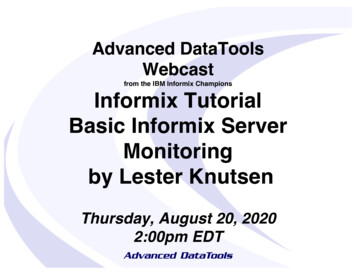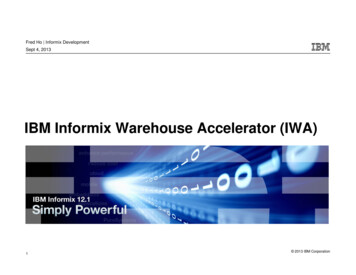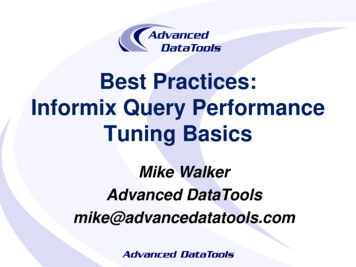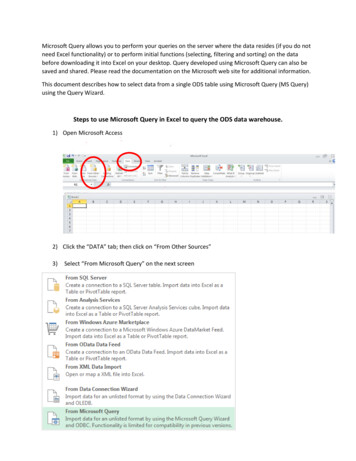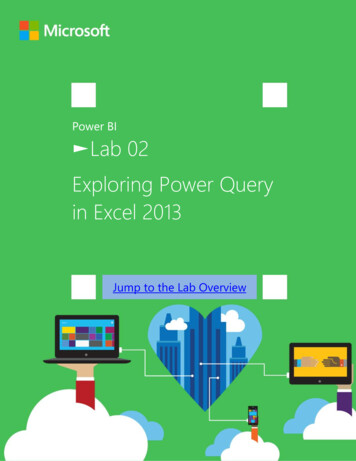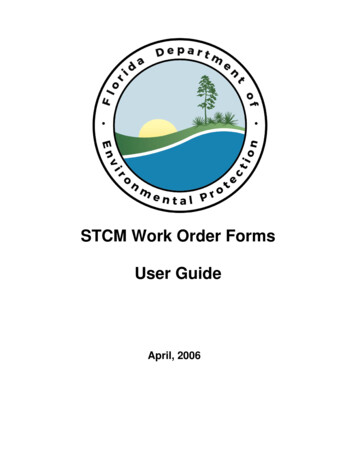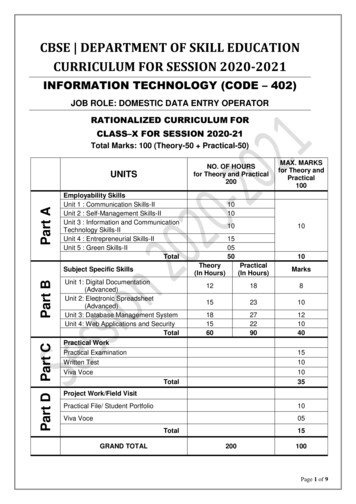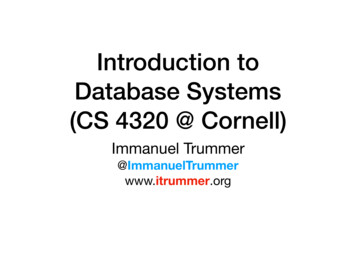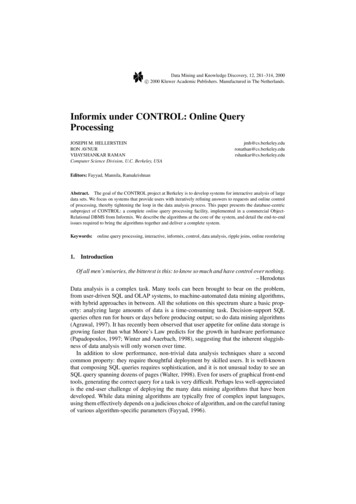
Transcription
Data Mining and Knowledge Discovery, 12, 281–314, 2000c 2000 Kluwer Academic Publishers. Manufactured in The Netherlands. Informix under CONTROL: Online QueryProcessingJOSEPH M. HELLERSTEINRON AVNURVIJAYSHANKAR RAMANComputer Science Division, U.C. Berkeley, nkar@cs.berkeley.eduEditors: Fayyad, Mannila, RamakrishnanAbstract. The goal of the CONTROL project at Berkeley is to develop systems for interactive analysis of largedata sets. We focus on systems that provide users with iteratively refining answers to requests and online controlof processing, thereby tightening the loop in the data analysis process. This paper presents the database-centricsubproject of CONTROL: a complete online query processing facility, implemented in a commercial ObjectRelational DBMS from Informix. We describe the algorithms at the core of the system, and detail the end-to-endissues required to bring the algorithms together and deliver a complete system.Keywords: online query processing, interactive, informix, control, data analysis, ripple joins, online reordering1.IntroductionOf all men’s miseries, the bitterest is this: to know so much and have control over nothing.– HerodotusData analysis is a complex task. Many tools can been brought to bear on the problem,from user-driven SQL and OLAP systems, to machine-automated data mining algorithms,with hybrid approaches in between. All the solutions on this spectrum share a basic property: analyzing large amounts of data is a time-consuming task. Decision-support SQLqueries often run for hours or days before producing output; so do data mining algorithms(Agrawal, 1997). It has recently been observed that user appetite for online data storage isgrowing faster than what Moore’s Law predicts for the growth in hardware performance(Papadopoulos, 1997; Winter and Auerbach, 1998), suggesting that the inherent sluggishness of data analysis will only worsen over time.In addition to slow performance, non-trivial data analysis techniques share a secondcommon property: they require thoughtful deployment by skilled users. It is well-knownthat composing SQL queries requires sophistication, and it is not unusual today to see anSQL query spanning dozens of pages (Walter, 1998). Even for users of graphical front-endtools, generating the correct query for a task is very difficult. Perhaps less well-appreciatedis the end-user challenge of deploying the many data mining algorithms that have beendeveloped. While data mining algorithms are typically free of complex input languages,using them effectively depends on a judicious choice of algorithm, and on the careful tuningof various algorithm-specific parameters (Fayyad, 1996).
282HELLERSTEIN, AVNUR AND RAMANA third common property of data analysis is that it is a multi-step process. Users areunlikely to be able to issue a single, perfectly chosen query that extracts the “desiredinformation” from a database; indeed the idea behind data analysis is to extract heretoforeunknown information. User studies have found that information seekers very naturallywork in an iterative fashion, starting by asking broad questions, and continually refiningthem based on feedback and domain knowledge (O’day and Jeffries, 1993). This iterationof analyses is a natural human mode of interaction, and not clearly an artifact of currentsoftware, interfaces, or languages.Taken together, these three properties result in a near-pessimal human-computer interaction: data analysis today is a complex process involving multiple time-consuming steps.A poor choice or erroneous query at a given step is not caught until the end of the stepwhen results are available. The long delay and absolute lack of control between successivequeries disrupts the concentration of the user and hampers the process of data analysis.Therefore many users eschew sophisticated techniques in favor of cookie-cutter reports,significantly limiting the impact of new data analysis technologies. In short, the mode ofhuman-computer interaction during data analysis is fundamentally flawed.1.1.CONTROL: Interactive data analysisThe CONTROL1 project attempts to improve the interaction between users and computersduring data analysis. Traditional tools present black box interfaces: users provide inputs,the system processes silently for a significant period, and returns outputs. Because of thelong processing times, this interaction is reminiscent of the batch processing of the 1960’sand ‘70’s. By contrast, CONTROL systems have an online mode of interaction: users cancontrol the system at all times, and the system continuously provides useful output in theform of approximate or partial results. Rather than a black box, online systems are intended tooperate like a crystal ball: the user “sees into” the online processing, is given a glimpse of thefinal results, and can use that information to change the results by changing the processing.This significantly tightens the loop for asking multiple questions: users can quickly senseif their question is a useful one, and can either refine or halt processing if the question wasnot well-formed. We describe a variety of interactive online systems in Section 2.Though the CONTROL project’s charter was to solve interface problems, we quicklyrealized that the solutions would involve fundamental shifts in system performance goals(Hellerstein, 1997). Traditional algorithms are optimized to complete as quickly as possible. By contrast, online data analysis techniques may never complete; users halt them whenanswers are “good enough”. So instead of optimizing for completion time, CONTROLsystems must balance two typically conflicting performance goals: minimizing uneventful“dead time” between updates for the user, while simultaneously maximizing the rate at whichpartial or approximate answers approach a correct answer. Optimizing only one of thesegoals is relatively easy: traditional systems optimize the second goal (they quickly achieve acorrect answer) by pessimizing the first goal (they provide no interactivity). Achieving bothgoals simultaneously requires redesigning major portions of a data analysis system, employing a judicious mix of techniques from data delivery, query processing, statistical estimationand user interfaces. As we will see, these techniques can interact in non-trivial ways.
INFORMIX UNDER CONTROL1.2.283Online query processing in informixIn this paper we focus on systems issues for implementing online query processing—i.e.,CONTROL for SQL queries. Online query processing enables a user to issue an SQL query,see results immediately, and adjust the processing as the query runs. In the case of an onlineaggregation query, the user sees refining estimates of the final aggregation results. In thecase of an online enumeration query (i.e., a query with no aggregation), the user receives anever-growing collection of result records, which are available for browsing via user interfacetools. In both cases, users should be able to provide feedback to the system while the queryis running, to control the flow of estimates or records. A common form of control is toterminate delivery of certain classes of estimates or records; more generally, users mightexpress a preference for certain classes of estimates or records over others.Online query processing algorithms are designed to produce a steady stream of outputrecords, which typically serve as input to statistical estimators and/or intelligent user interfaces. Our discussion here focuses mostly on the pipelined production of records and thecontrol of that data flow; statistical and interface issues are considered in this paper onlyto the extent that they drive the performance goals, or interact with implementation issues.The interested reader is referred to Section 1.4 for citations on the statistical and interfaceaspects of online query processing.As a concrete point of reference, we describe our experience implementing online queryprocessing in a commercial object-relational database management system (DBMS): Informix’s Dynamic Server with Universal Data Option (UDO) (Informix, 1998). The pedigree of UDO is interesting: formerly known as Informix Universal Server, it representsthe integration of Informix’s original high-performance relational database engine withthe object-relational facilities of Illustra (Illustra, 1994), which in turn was the commercialization of the Postgres research system (Stonebraker and Kemnitz, 1991). InformixCorporation made its source code and development environment available to us for thisresearch, enabling us to test our ideas within a complete SQL database engine.Working with UDO represented a significant challenge and opportunity. UDO is a largeand complex system developed (in its various ancestral projects) over more than 15 years.As we describe in Hellerstein et al. (1997), online query processing cannot simply beimplemented as a “plug-in” module for an existing system. Most of the work described inthis paper involved adding significant new features to the UDO database engine itself. In afew cases—particularly in crafting an API for standard client applications—we were able toleverage the object-relational extensibility of UDO to our advantage, as we describe below.In addition to adding new algorithms to the system, a significant amount of effort wentinto architecting a complete end-to-end implementation. Our implementation allows thevarious algorithms to be pipelined into complex query plans, and interacts effectively witha wide variety of client tools. This paper describes both the core algorithms implementedin UDO, as well as the architectural issues required to provide a usable system.1.3.Structure of the paperWe discuss related work in Section 1.4. In Section 2 we describe a number of applicationscenarios for CONTROL-based systems. Section 3 describes the core algorithms used in
284HELLERSTEIN, AVNUR AND RAMANonline query processing including access methods, data delivery algorithms, and join algorithms. Section 4 describes the end-to-end challenges of putting these algorithms togetherin the context of a commercial object-relational database management system. Section 5demonstrates the performance of the system, in terms both of interactivity and rate ofconvergence to accurate answers. In Section 6 we conclude with a discussion of futurework.1.4.Related workThe CONTROL project began by studying online aggregation, which was motivated in(Hellerstein (1997a) and Hellerstein et al. (1997). The idea of online processing has beenexpanded upon within the project (Hellerstein, 1997b; Hellerstein, 1998a; Hellerstein et al.,1999; Hidber, 1997) a synopsis of these thrusts is given in Section 2. Recently we havepresented the details of two of our core query processing algorithms: ripple joins (Haas andHellerstein, 1999) and online reordering (Raman et al., 1999). Estimation and confidenceinterval techniques for online aggregation are presented in Haas (1996, 1997) and Haas andHellerstein (1999). To our knowledge, the earliest work on approximate answers to decisionsupport queries appears in Morgenstein’s dissertation from Berkeley (Morgenstein, 1980),in which he presents motivation quite similar to ours, along with proposed techniques forsampling from relations and from join results.Our work on online aggregation builds upon earlier work on estimation and confidenceintervals in the database context (Hou et al., 1988; Haas et al., 1996; Lipton et al., 1993).The prior work has been concerned with methods for producing a confidence interval witha width that is specified prior to the start of query processing (e.g. “get within 2% of theactual answer with 95% probability”). The underlying idea in most of these methods isto effectively maintain a running confidence interval (not displayed to the user) and stopsampling as soon as the length of this interval is sufficiently small. Hou, et al. (1989) considerthe related problem of producing a confidence interval of minimal length, given a real-timestopping condition (e.g. “run for 5 minutes only”). The drawback with using samplingto produce approximate answers is that the end-user needs to understand the statistics.Moreover, making the user specify statistical stopping conditions at the beginning reducesthe execution time but does not make the execution interactive; for instance there is noway to dynamically control the rate of processing—or the desired accuracy—for individualgroups of records.More recent work has focused on maintaining precomputed summary statistics for approximately answering queries (Gibbons and Matias, 1998; Gibbons et al., 1998); Olkenalso proposed the construction of sample views (Olken, 1993). In a similar though simpler vein, Informix has included simple precomputed samples for approximate results toROLAP queries (Informix, 1998). These techniques are to online query processing what materialized views are to ad hoc queries: they enhance performance by precomputing results,but are inapplicable when users ask queries that cannot exploit the precomputed results.In the context of approximate query answers, ad hoc specification applies both to queriesand to the stopping criteria for sampling: a user may specify any query, and want to see
INFORMIX UNDER CONTROL285answers with differing accuracies. Unlike general materialized views, most precomputedsummaries are on single tables, so many of the advantages of precomputed samples can beachieved in an online query processing system via simple buffer management techniques. Inshort, work on precomputed summaries is complementary to the techniques of this paper; itseems viable to automate the choice and construction of precomputed summaries as an aidto online query processing, much as Hybrid OLAP chooses queries to precompute to aidOLAP processing (Shukla et al., 1998; Harinarayan et al., 1996; Pilot Software, 1998; SQL,1998).A related but quite different notion of precomputation for online query processing involvessemantically modeling data at multiple resolutions (Silberschatz et al., 1992). A version ofthis idea was implemented in a system called APPROXIMATE (Vrbsky and Liu, 1993). Thissystem defines an approximate relational algebra which it uses to process standard relationalqueries in an iteratively refined manner. If a query is stopped before completion, a supersetof the exact answer is returned in a combined extensional/intensional format. This modelis different from the type of data browsing we address with online query processing: it isdependent on carefully designed metadata and does not address aggregation or statisticalassessments of precision.There has been some initial work on “fast-first” query processing, which attempts toquickly return the first few tuples of a query. Antoshenkov and Ziauddin report on theOracle Rdb (formerly DEC Rdb/VMS) system, which addresses the issues of fast-firstprocessing by running multiple query plans simultaneously; this intriguing architecture requires some unusual query processing support (Antoshenkov and Ziauddin, 1996). Bayardoand Miranker propose optimization and execution techniques for fast-first processing using nested-loops joins (Bayardo and Miranker, 1996). Carey and Kossman (1997, 1998),Chaudhuri and Gravano (1996, 1999), and Donjerkovic and Ramakrishnan (1999) discusstechniques for processing ranking and “top-N ” queries, which have a “fast-first” flavor aswell. Much of this work seems applicable to online query optimization, though integrationwith online query processing algorithms has yet to be considered. Fagin (1998) proposesan interesting algorithm for the execution of ranking queries over multiple sources thatoptimizes for early results. This algorithm has a similar flavor to the Ripple Join algorithmwe discuss in Section 3.3.2.Application scenarios and performance requirementsThe majority of data analysis solutions are architected to provide black-box, batch behaviorfor large data sets: this includes software for the back-office (SQL decision-support systems),the desktop (spreadsheets and OLAP tools), and statistical analysis techniques (statisticspackages and data mining). The result is that either the application is frustratingly slow(discouraging its use), or the user interface prevents the application from entering batchstates (constraining its use.) The applications in this section are being handled by currenttools with one or both of these approaches. In this section we describe online processingscenarios, including online aggregation and enumeration, and online visualization. We alsobriefly mention some ideas in online data mining.
2862.1.HELLERSTEIN, AVNUR AND RAMANOnline aggregationAggregation queries in relational database systems often require scanning and analyzing asignificant portion of a database. In current relational systems such query execution has batchbehavior, requiring a long wait for the user. Online query processing can make aggregationan interactive process.Consider the following simple relational query:SELECT college, AVG(grade)FROM enrollGROUP BY college;This query requests that all records in the enroll table be partitioned into groups by college,and then for each college its name and average grade should be returned. The output of thisquery in an online aggregation system can be a set of interfaces, one per output group, asin figure 1. For each output group, the user is given a current estimate of the final answer.In addition, a graph is drawn showing these estimates along with a description of theiraccuracy: each estimate is drawn with bars that depict a confidence interval, which says thatFigure 1.An online aggregation interface.
INFORMIX UNDER CONTROL287with X % probability, the current estimate is within an interval of ² from the final answer(X is set to 95% in the figure). The “Confidence” slider on the lower left allows the userto control the percentage probability, which in turn affects the 2 · ² width of the bars. Inaddition, controls on the upper left of the screen are provided to stop processing on a group,or to speed up or slow down one group relative to others. These controls allow the user todevote more processing to groups of particular interest. These interfaces require the supportof significant modifications to a DBMS, which we describe in this paper. We have developedestimators and corresponding implementation techniques for the standard SQL aggregatesAVG, COUNT, and STDDEV2 (Hellerstein et al., 1997; Hass and Hellerstein, 1999).Online aggregation is particularly useful in “drill-down” scenarios: a user may ask foraggregates over a coarse-grained grouping of records, as in the query above. Based on aquick online estimate of the coarse-grained results, the user may choose to issue anotherquery to “drill down” into a set of particularly anomalous groups. Alternatively the usermay quickly find that their first query shows no interesting groups, and they may issue analternate query, perhaps grouping on different attributes, or requesting a different aggregatecomputation. The interactivity of online aggregation enables users to explore their data ina relatively painless fashion, encouraging data browsing.The obvious alternative to online aggregation is to precompute aggregation results before people use the system—this is the solution of choice in the multidimensional OLAP(MOLAP) tools (e.g., Hypersion Essbase OLAP Server, 1999). Note that the name OLAP(“OnLine Analytic Processing”) is something of a misnomer for these systems. The analyticprocessing in many OLAP tools is in fact done “off line” in batch mode; the user merelynavigates the stored results on line. This solution, while viable in some contexts, is an example of the constrained usage mentioned at the beginning of this section: the only interactivequeries are those that have been precomputed. This constraint is often disguised with agraphical interface that allows only precomputed queries to be generated. A concomitantand more severe constraint is that these OLAP systems have trouble scaling beyond a fewdozen gigabytes because of both the storage costs of precomputed answers, and the timerequired to periodically “refresh” those answers. Hybrids of precomputation and onlineaggregation are clearly possible, in the same way that newer systems provide hybrids ofprecomputation and batch query processing (e.g., Shukla et al., 1998; Harinarayan et al.,1996; Pilot Software, 1998; Maier and Stein, 1986).2.2.Online enumeration: Scalable spreadsheetsDatabase systems are often criticized as being hard to use. Many data analysts are expertsin a domain other than computing, and hence prefer simple direct-manipulation interfaceslike those of spreadsheets (Shneiderman, 1982), in which the data is at least partially visibleat all times. Domain-specific data patterns are often more easily seen by “eyeballing” aspreadsheet than by attempting to formulate a query. For example, consider analyzing atable of student grades. By sorting the output by GPA and scrolling to the top, middle, andbottom, an analyst may notice a difference in the ethnic mix of names in different GPAquantiles; this may be evidence of discrimination. By contrast, imagine trying to write an
288HELLERSTEIN, AVNUR AND RAMANSQL aggregation query asking for the average grade per apparent ethnicity of the namecolumn—there is no way to specify the ethnicity of a name declaratively. The difficulty isthat the (rough) name-to-ethnicity mapping is domain knowledge in the analyst’s head, andnot captured in the database.Unfortunately, spreadsheets do not scale gracefully to large datasets. An inherent problemis that many spreadsheet behaviors are painfully slow on large datasets—if the spreadsheetallows large data sets at all. Microsoft Excel, for example, restricts table size to 64K rows orfewer, presumably to ensure interactive behavior. The difficulty of guaranteeing acceptablespreadsheet performance on large datasets arises from the “speed of thought” response timeexpected of spreadsheet operations such as scrolling, sorting on different columns, pivoting,or jumping to particular cells in the table (by address or cell-content prefix). Thus traditionalspreadsheets are not useful for analyzing large amounts of data.We are building A-B-C, a scalable spreadsheet that allows online interaction with individual records (Raman et al., 1999a). As records are enumerated from a large file or a databasequery returning many rows, A-B-C allows the user to view example rows and perform typicalspreadsheet operations (scroll, sort, jump) at any time. A-B-C provides interactive (subsecond) responses to all these operations via the access methods and reordering techniquesof Sections 3.1 and 3.2.Hypotheses formed via online enumeration can be made concrete in A-B-C by groupingrecords “by example”: the user can highlight example rows, and use them to interactivelydevelop a regular expression or other group identity function. Groups are then “rolled up” ina separate panel of the spreadsheet, and users can interactively specify aggregation functionsto compute on the groups online. In this case, the online enumeration features of A-B-C area first step in driving subsequent online aggregation.2.3.Aggregation enumeration: Online data visualizationData visualization is an increasingly active research area, with rather mature prototypes inthe research community (e.g. Tioga Datasplash (Aiken et al., 1996), DEVise (Livny et al.,1997), Pad (Perlin and Fox, 1993)), and products emerging from vendors (Ohno, 1998).These systems are interactive data exploration tools, allowing users to “pan” and “zoom”over visual “canvases” representing a data set, and derive and view new visualizationsquickly.An inherent challenge in architecting a data visualization system is that it must presentlarge volumes of information efficiently. This involves scanning, aggregating and renderinglarge datasets at point-and-click speeds. Typically these visualization systems do not drawa new screen until its image has been fully computed. Once again, this means batch-styleperformance for large datasets. This is particularly egregious for visualization systems thatare expressly intended to support browsing of large datasets.Related work in the CONTROL project involves the development of online visualizationtechniques we call CLOUDS (Hellerstein et al., 1999), which can be thought of as visualaggregations and enumerations for an online query processing system. CLOUDS performsboth enumeration and aggregation simultaneously: it renders records as they are fetched,and also uses those records to generate an overlay of shaded rectangular regions of color
INFORMIX UNDER CONTROLFigure 2.289Snapshots of an online visualization of cities in the United States, with and without CLOUDS.(“clouds”), corresponding to nodes in a carefully constructed quad tree. The combination ofthe clouds and the rendered sample is intended to approximate the final image. This meansthat the clouds are not themselves an approximation of the image, but rather a compensatoryshading that accounts for the difference between the rendered records and the projected finaloutcome. During processing, the user sees the picture improve much the way that imagesbecome refined during network transmission. This can be particularly useful when a userpans or zooms over the results of an ad hoc query: in such scenarios the accuracy of what isseen is not as important as the rough sense of the moving picture. Figure 2 shows a snapshotof an online visualization of cities in the United States, with and without CLOUDS. Notehow the CLOUDS version contains shading that approximates the final density of areasbetter than the non-CLOUDS version; note also how the CLOUDS visualization rendersboth data points and shading.As with the Scalable Spreadsheet, our data visualization techniques tie into data delivery,and benefit directly from the access methods and reordering techniques described in Sections3.1 and 3.2. For DBMS-centric visualization tools like DEVise and Tioga, the full power ofan online query processing system—including joins, aggregations, and so on—is neededin the back end.2.4.Online data miningMany data mining algorithms make at least one complete pass over a database beforeproducing answers. In addition, most mining algorithms have a number of parameters totune, which are not adjustable while the algorithm is running. While we do not focus ondata mining algorithms in this paper, we briefly consider them here to highlight analogiesto online query processing.As a well-known example, consider the oft-cited apriori algorithm for finding “association rules” in market-basket data (Agrawal and Srikant, 1994). To use an association ruleapplication, a user specifies values for two variables: one that sets a minimum threshold
290HELLERSTEIN, AVNUR AND RAMANon the amount of evidence required for a set of items to be produced (minsupport) andanother which sets a minimum threshold on the correlation between the items in the set(minconfidence). These algorithms can run for hours without output, before producing association rules that passed the minimum support and confidence thresholds. Users who setthose thresholds incorrectly typically have to start over. Setting thresholds too high meansthat few rules are returned. Setting them too low means that the system (a) runs even moreslowly, and (b) returns an overwhelming amount of information, most of which is useless.Domain experts may also want to explicitly prune irrelevant correlations during processing.The traditional algorithm for association rules is a sequence of aggregation queries,and can be implemented in an online fashion using techniques for online query processingdescribed in this paper. An alternative association rule algorithm called CARMA was developed in the CONTROL project (Hidber, 1997). While not clearly applicable to SQL queryprocessing, CARMA is worthy of mention here for two reasons. First, it very efficiently provides online interaction and early answers. Second—and somewhat surprisingly—CARMAoften produces a final, accurate answer faster than the traditional “batch” algorithms, bothbecause it makes fewer passes of the dataset and because it manages less memory-residentstate. So in at least one scenario, inventing an algorithm for online processing resulted in asolution that is also better for batch processing!Most other data mining algorithms (clustering, classification, pattern-matching) are similarly time-consuming. CONTROL techniques seem worth considering for these algorithms,and the development of such techniques seems to be a tractable research challenge. Notethat CONTROL techniques tighten loops in the knowledge-discovery process (Fayyad et al.,1996), bringing mining algorithms closer in spirit to data visualization and browsing. Suchsynergies between user-driven and automated techniques for data analysis seem like apromising direction for cross-pollenation between research areas.3.Algorithms for online query processingRelational systems implement a relatively small set of highly tuned query processing operators. Online query processing is driven by online analogs of the standard relational queryprocessing operators, along with a few new operators. In this section we discuss our implementation in Informix of online query processing operators, including randomized dataaccess, preferential data delivery, relational joins, and grouping of result records. Of these,randomized data access was the simplest to address, and our solution required no additionsto the Informix SQL engine. It does, however, have an impact on the physical design of adatabase, i.e., the layout of tables and indexes on disk.3.1.Randomized data access and physical database designIn most scenarios, it is helpful if the output of a partially-completed online query can betreated as a random sample. In on
CONTROL for SQL queries. Online query processing enables a user to issue an SQL query, see results immediately, and adjust the processing as the query runs. In the case of an online aggregation query, the user sees refining estimates of the final aggregation results. In the case of an online enumeration query (i.e., a query with no .
